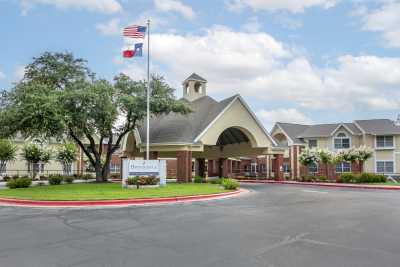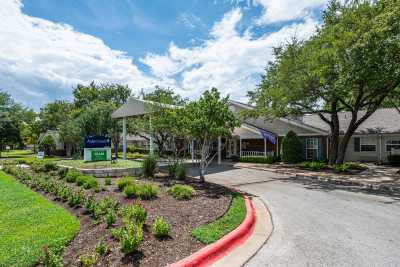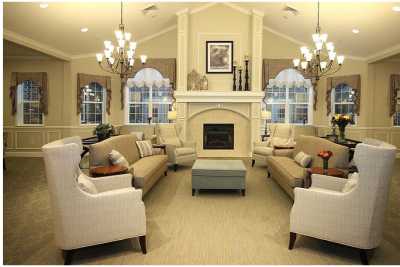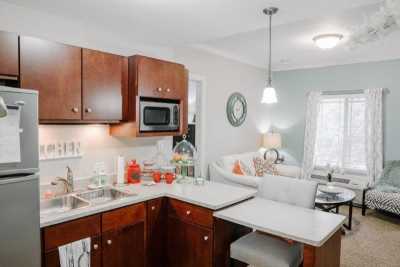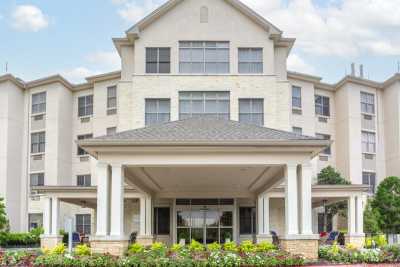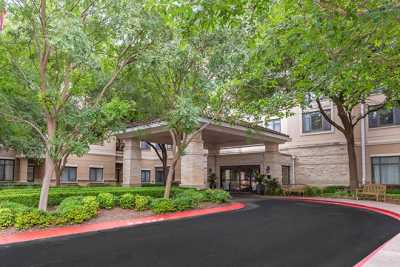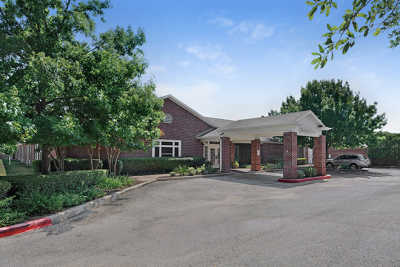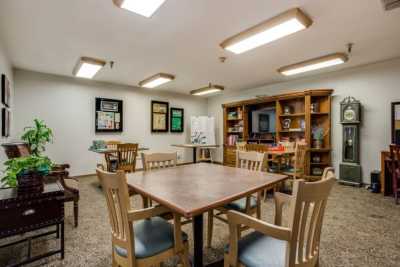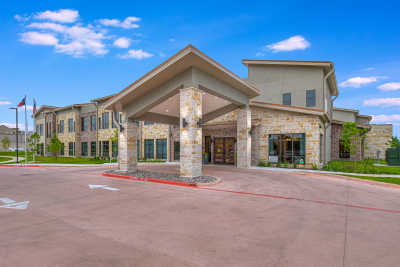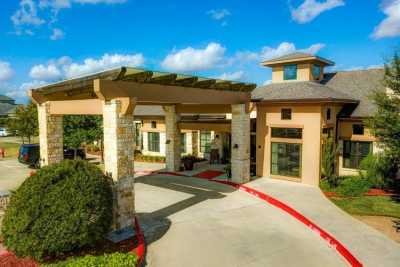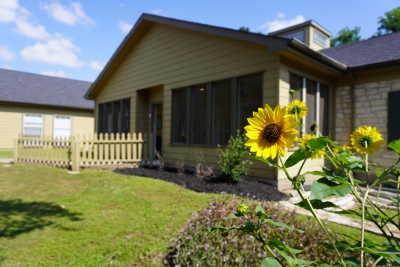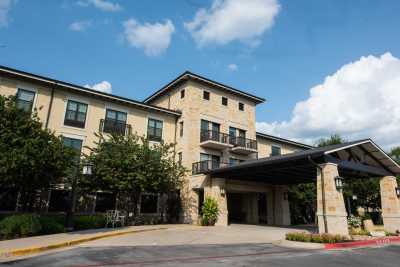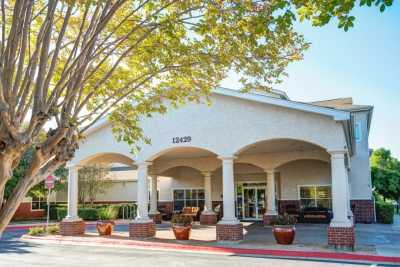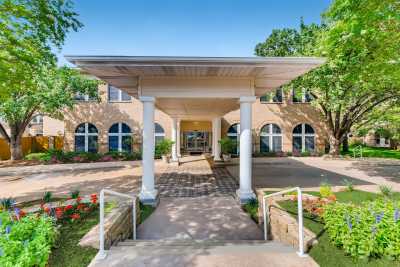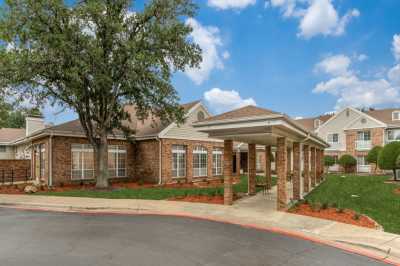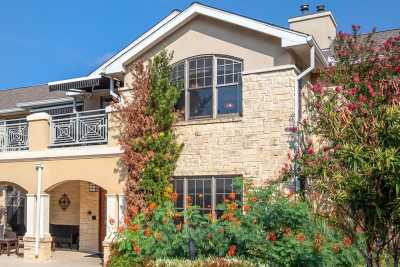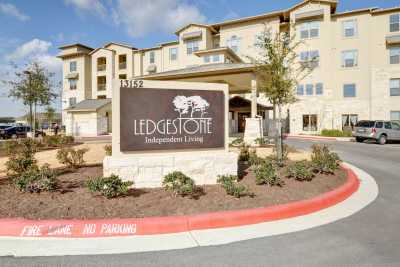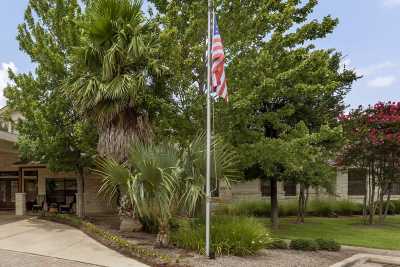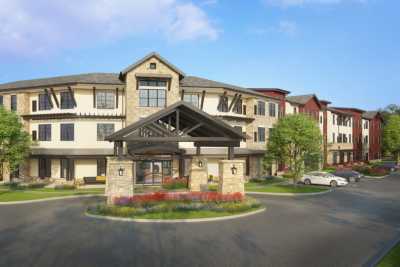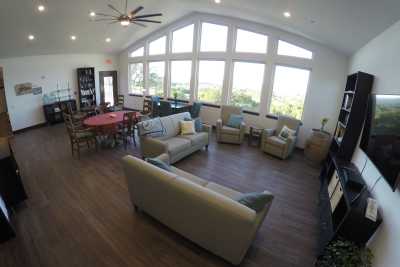
10 Best Assisted Living Facilities in Austin, TX
Austin, Texas, is a growing metropolis offering delicious food, live music, and a wide variety of activities. These factors have made it an increasingly popular retirement destination in recent years. Luckily, the senior living scene is adapting to the increase — A Place for Mom’s network features 24 assisted living facilities within a 10-mile radius of downtown Austin.
Assisted living enables seniors to reside in a safe, engaging space where caregivers assist them with their daily needs and chores. And, without the daily stressors of life, seniors can dedicate themselves to their favorite pastimes and hobbies by utilizing luxurious on-site amenities and participating in community activities.
In this guide to assisted living in Austin, you’ll be able to narrow down options for a senior loved one based on factors that matter most to you — highest overall ratings, affordability, dining options, amenities, services, and more. Furthermore, we use our 20+ years of experience in the senior living industry and proprietary data to inform this guide. You’ll find local data and helpful information on local costs, how seniors pay, local assisted living features, senior demographics, and senior-specific resources and activities in the Austin, Texas, area.
Austin Assisted Living Facilities | 1110 Reviews
After our mom passed in January, my brother and I needed to put Dad somewhere where he could get the care that he needed. He was diagnosed with Lowy Body Dementia and it escalated after mom's passing. We...
The cleanness of the facility is great, in the past I would tour other places, and the smell of other facilities were very unpleasant. The Care staff is very friendly and caring. Every time I go to visit my...

I have had continuous, positive experiences with the staff at the Pavilion Great Hills. All of the ones that I have come in contact with have been consistently superb! The staff at the front desk, the dining...
It all starts with the leader and [name removed] is awesome. She has a genuine concern for her staff and the residence. The staff has a friendly demeanor towards all the residence. Communication is good and...
The concierge is sometimes a bit brusk. What I really like about the community is the food quality and I would recommend Brookdale Gaines Ranch to other families who may need a place for their loved ones.
We moved our mother from another community and the experience and care has been remarkable my mother is so happy and at peace now.
The facility is not too large and therefore, I think there is a greater level of care. Everyone who works there, including the manager chips and to help when needed. The have won several awards over the...
Parsons house is a great fit for our family. The location is very central. The staff is caring and accomadating. My brother is safe and well taken care of. The food is very good. I can highly recommend the...
Highly recommend. Staff are friendly but like all other places, staff turn around was often. We picked them because it was the newest, smaller than others, and cost
Our free advisors can help
- Compare local facilities
- Determine care type
- Schedule tours
- Evaluate pricing
The community is bright, happy, clean and stimulating for the residents. The Auberge at Onion Creek has been a true blessing for our family.
When I had both parents at the location it was of value-5. After my parent passed away the cost of value went to a 0.5 because it was higher for one person than two and did not make sense. Our family...
5 for all. We lost mom in November and could not have been better supported and loved and cared for until the end. I never felt any anxiety as I left the parking lot after a visit. I absolutely trusted them...
My sister had been recently diagnosed with dementia. I had to travel and couldn't leave her alone. She initially refused to go. The first couple of days were horrible. She called several times wanting me to...
My loved one is currently a resident at Asher Point Senior Living of Austin and the experience at this facility has been great for her so far, even with new ownership. Based on our experience, I would...
The front office staff at Juniper Village at Spicewood Summit is friendly and calm The care staff nursing is great, but some of the day to day care staff do not perform up to expected standards with brief...
At Isle at Cedar Ridge, every day is a new opportunity for happiness and health. The range of activities, the focus on wellness, and the constant companionship make this place more than a residence—it's a...
I'm pleased with the overall experience. The home was always kept clean, bedroom, and clothing as well. Language barrier created some inconvenience. Straps, or lifting belts should be used to eliminate...
I have been a resident for about one and a quarter years. There have been a number of problems due to weather and equipment failures. In all cases management made an exceptional effort to keep us fed and as...
I would like more craft activities. Hopefully the dining room and kitchen are finished soon. The washer and dryer are not good appliances. Otherwise I'm happy with Ledgestone.
Overall my wife and I are happy with the facility. The turnover is as expected and causing issues with the med management. However, the performance of the permanent personnel is exceptional. My mother is a...
1. 4 - Unfortunately, when my mom was being admitted another management company was on its way out and nothing was said when we were admitted. Only found out the next week that a transition was about to...
I would tell others to just be involved. The staff truly want and welcome family at anytime!! They have lots of activities offered. The residents are out and about- and encouraged to not sit in their...
Mother loves the care and attention she gets on a daily basis. It is a small facility with a fantastic staff to resident ratio. Everyone in the facility is very kind and compassionate. She went from being...
Our methodology
How we rank order the Austin community options above
We developed a proprietary recommendation system that orders Austin community options based on factors we know are important to seniors and their families:
- Proximity to your search location
- Availability of recent, high-quality reviews
- The amount of detailed community information available
Where we source our information
14,000+ communities
We collect proprietary data from our network of 14,000+ senior living communities in the U.S., with regular refreshes of data and information
350,000+ reviews
We have 387,000+ reviews from senior living residents and family members that provide first-hand accounts about senior living communities
- Costs of assisted living in Austin, Texas, area
- What families are saying about assisted living in Austin
- How people pay for assisted living in Austin, Texas
- Understand Texas laws and regulations for assisted living facilities
- What to expect from assisted living in Austin
- Austin assisted living services and amenities
- Explore senior care with confidence
- Unfamiliar with Austin? Highlights for seniors
Costs of assisted living in Austin, Texas, area
The cost of Austin assisted living depends on a number of factors — location, floor plan, amenities, and your senior loved one’s required level of care. However, the median cost of rent, excluding add-on fees for services and amenities, is $5,280 per month, according to A Place for Mom’s 2022-2023 proprietary data.[01]
This cost may seem steep at first, so it’s important to remember that rent at assisted living apartments in Austin, Texas, typically includes the following amenities:
- A dining plan with three meals and snacks daily
- On-site amenities (fitness centers, pools, craft centers, libraries, movie theaters, courtyards, etc.)
- On-site activities (interest clubs, game nights, holiday parties, fitness classes, etc.)
- Day trips and outings to local attractions and events
- General maintenance and landscaping
Seniors may have to pay additional fees for the following on-site amenities and services in an Austin assisted living community:
- Personalized care services (assistance with activities of daily living, medication administration, catheter care, etc.)
- Pet rent and additional occupant fees
- Room service and special meal accommodations
- Housekeeping and laundry services
- Beauty salon and barber shop services
- Transportation services
The following costs don’t include any add-on fees for care; however, they do provide a good cost comparison of nearby areas in Austin.
Average monthly cost of Assisted Living in Austin, TX vs. nearby cities
Average monthly cost of Assisted Living in Austin, TX vs. the state and national average
Average monthly cost of Assisted Living in Austin vs. other types of senior living
Median monthly costs of Assisted Living in Austin, TX by room type
What families are saying about assisted living in Austin
Recent reviews for assisted living in Austin
Brookdale Lohmans Crossing in Austin, TX
Mallard Home Care in Pflugerville, TX
Sodalis Austin
Reviews mention these favorite features of communities
Austin review score based on 270 family reviews
This proprietary review score is based on 270 reviews of 47 Austin assisted living communities. All reviews were submitted in the past two years by verified community residents and family members.Austin review score compared against nearby cities
Review subcategories for Austin assisted living
When assisted living residents and family members submit a review on our site, they rate each community on categories such as cleanliness, activities, meals, and more. The chart below is based on 270 reviews of 47 Austin assisted living communities. This chart helps you compare Austin resident and family assisted living satisfaction rates against national averages. Use it to assess your needs and develop criteria for your own search. If you know that one of these categories is important to you or your loved one, our senior living advisors can help you find communities to match your needs.How people pay for assisted living in Austin, Texas
There are several ways for seniors to pay for assisted living in Austin. Most seniors use a combination of private retirement funds, insurance policies, and federal and state programs. In this section, you’ll find useful information on how you can use private pay methods, veterans benefits, Medicare, and Medicaid to cover some of your loved one’s medical and assisted living costs.
Seniors and families typically look at private payment methods when they initially start planning for assisted living. Private pay includes all of a senior’s personal income and asset resources. Their income might include savings accounts, retirement pensions, investment returns, and/or Social Security benefits, all of which can be used to pay for assisted living. And luckily Texas doesn’t levy a personal income tax, meaning these income sources aren’t taxed.
Depending on your loved one’s resources and current situation, they may combine a few of the following private payment methods to cover costs of assisted living. Keep in mind that long-term care insurance policies vary in what they cover, so it’s best practice to consult with your loved one’s policy provider. Learn more about unique private pay methods below:
Can veterans benefits be used to pay for assisted living in Austin?
If your senior loved one is a veteran, they can use funds provided by the U.S. Department of Veterans Affairs (VA) to pay for rent at an Austin assisted living community. Senior veterans and their surviving spouses may be eligible for VA pension benefits. The Aid and Attendance benefit is especially important for qualifying seniors as it can be added to their existing VA pension benefits to cover anything that improves a senior’s life — which could include assisted living.
Who qualifies for veterans benefits?
If you’re unsure about your loved one’s eligibility for VA benefits, the best place to start is by reaching out to a local Veteran Service Organization (VSO). VSOs are vetted by the VA and will happily help you and your loved one find options you may not know about. They’ll also help you successfully file for a claim or appeal a denied claim. In Austin, assisted living communities also sometimes partner with local veteran programs to help potential senior residents obtain their entitled benefits.
Approximate number of veterans currently living in Austin
Approximately 39% of Austin veterans are 65+
Resources for Austin veterans
Travis County Veterans Services Department
5325 Airport Blvd.
Austin, TX 78751
Phone: 512-854-9340
Hours: Monday through Thursday, 9 a.m. – 4 p.m. (By appointment only)
Virtual contact: Veterans services contact form
Texas Veterans Commission (TVC)
1700 N. Congress Ave., Suite 800
Austin, TX 78701
Phone: 512-475-2395
Regional Disabled American Veterans (DAV) office
VA Regional Office — One Veterans Plaza
701 Clay Ave.
Waco, TX 76799
Phone: 254-299-9932
Hours: Monday through Friday, 8:30 a.m. – 4 p.m.
Medicaid is a public health insurance program that is jointly funded by the state and federal governments. Even though it cannot be used to pay rent at an assisted living community, it can help cover some long-term health care services and medically necessary care services within an assisted living community.
STAR+PLUS Medicaid program
The Texas Health and Human Services Commission (or HHSC) operates a Medicaid program called STAR, which offers a managed care program specifically for seniors 65+ and individuals with disabilities called STAR+PLUS. In addition to routine health care costs, the STAR+PLUS program covers long-term care services, which include the following:
- Nursing and personal care services
- Therapy extension services
- Nutrition services
- Transportation services
Keep in mind that STAR+PLUS can only cover health care and long-term care services through agencies licensed and certified by the Texas Health and Human Services Commission.
For additional services to be covered within an assisted living facility, seniors must be eligible for the Home and Community Based Services (HCBS) Medicaid waiver program. This waiver can be used in assisted living facilities contracted with the resident’s managed care provider. This HCBS waiver enables seniors to reside and receive care in a residential setting like an assisted living community rather than an institutional setting like a nursing home.[03]
The STAR+PLUS HCBS waiver program can help cover the following costs in assisted living:
- Personal care
- Medical supplies
- Nursing services
- Respite care
- Physical, occupational, and speech therapies
- Adaptive aids, such as eyeglasses, hearing aids, orthotic devices, and orthopedic shoes[04]
When a senior applies for Medicaid, Texas Health and Human Services will assess their need for the HCBS program. As of 2023, seniors must meet the following eligibility requirements:
- Be 65 years of age or older
- Require an institutional level of care, commonly found in a nursing facility
- Earn less than $2,742 per month as an individual or $5,484 as a couple[05]
Note for Home and Community Based Services (HCBS) settings: Not all assisted living facilities in Austin qualify as an HCBS setting; however, some will. In order to qualify, a facility must do the following:
- Be integrated into the greater local community
- Enable interested residents to seek work or volunteer opportunities
- Help the senior resident engage in local community life
- Allow the senior to control their own resources and finances
- Allow the senior to receive Medicaid care services[03]
If you need help understanding your loved one’s eligible Medicaid benefits, find a Texas Health and Human Services office near you or search for local programs through their services search tool. You can also contact your local area agencies on aging (or AAAs) for assistance in accessing local long-term care services and disability programs. Below, you’ll find more resources to help you better understand Medicaid benefits for seniors along with search tools that’ll help you locate Medicaid benefits offices in Austin.
Austin resident Medicaid resources
Medicare is a federal health insurance program that provides coverage to adults aged 65 and older and individuals with disabilities. It cannot be used to cover room and board costs in an Austin assisted living community, but it can help cover some medically necessary care costs within an assisted living facility.
The following Texas programs can help you save on Medicare costs and apply for Medicare benefits:
- The Texas Medicare Savings Program covers some Medicare Parts A and B premiums, deductibles, copayments, and/or coinsurance. Part A covers hospital stays, care in a skilled nursing facility, hospice care, and some home health care services. Part B covers certain doctors’ services, outpatient care, medical supplies, and preventive services.
As of 2022, seniors must not exceed a monthly income of $1,133 as an individual or $1,526 as a couple to qualify for this program.[06]
- The Texas Legal Services Center (TLSC) houses the Health Information, Counseling, and Advocacy Program (commonly referred to as HICAP) and the Legal Hotline for Texans to offer seniors legal advice, referrals, and assistance with Medicare.
Dual Medicare and Medicaid coverage in Austin
If your senior loved one qualifies for both Medicare and Medicaid, they’re eligible to receive dual coverage through one Medicare-Medicaid Plan (MMP) in Texas. This program is called the Dual Eligible Integrated Care Demonstration Project and is commonly referred to as “the Demonstration.” The Demonstration strives to improve service coordination, enhance quality of care, eliminate cost shifting between Medicare and Medicaid, and reduce costs for both the Texas and federal governments.
To qualify for the Demonstration, a senior must meet the following eligibility criteria:
- Have Medicare Parts A, B, and D and receive full Medicaid benefits
- Be enrolled in the STAR+PLUS program for at least 30 days
Dual-eligible individuals should be automatically enrolled and may choose to opt out of the Demonstration after they receive a letter in the mail notifying them of their enrollment. To request additional information on this program, email managed_care_initiatives@hhsc.state.tx.us.
For additional assistance with your loved one’s eligible Medicare benefits and enrollment, you can visit the Medicare website or call 2-1-1. You can also contact a local long-term care ombudsman, as they advocate for the health care rights of assisted living residents and help families learn about senior living options and payment methods. The Capital Area Council of Governments also helps Austin seniors access the long-term care they need. It provides benefits counseling, caregiver support, and more to aging Austin residents.
Austin resident Medicare resources
Texas Health Information, Counseling, and Advocacy Program (HICAP)
Phone: 800-252-9240
The Legal Hotline for Texans
Phone: 800-622-2520, ext. 3
Hours: Monday through Friday, 8:30 a.m. – 5 p.m.
Long-term care ombudsman
Clement “Pete” Moreno, managing local ombudsman at the AAA of the Capital Area
6800 Burleson Road, Building 310, Suite 165
Austin, TX 78744
Phone: 512-916-6054
Email: cpmoreno@capcog.org
Understand Texas laws and regulations for assisted living facilities
In Texas, all assisted living facilities must be licensed and certified by Texas Health and Human Services (also known as HHS) in order to operate and house residents. Texas Health and Human Services refers to assisted living facilities as ALFs and categorizes them into Type A and Type B. Here’s how the two differ:
- Type A ALFs house residents who don’t require routine attendance and are capable of following directions in an emergency situation.
- Type B ALFs provide care to residents who require nighttime attendance and assistance for evacuation during emergencies.[07]
Most stand-alone assisted living facilities qualify as Type A, while facilities with memory care and/or other specialized care units typically qualify as Type B. In Austin, assisted living facilities must meet several standards to remain licensed.
Assisted living staffing and training regulations
- Assisted living facility managers must complete a course in management of assisted living facilities. The course must cover general assisted living standards, resident characteristics, resident assessments, skills to care for residents, and information on food and nutrition services. Training must also include community resources, ethics, financial management, and federal laws — especially accessibility laws under the Americans with Disabilities Act.
- Assisted living facilities must have caregivers on-site 24 hours a day. They’re required to complete 4 hours of orientation before assuming any caregiver responsibilities, and they must complete 16 hours of supervised, on-the-job training. Training should include assistance with activities of daily living (ADLs), safety measures, fall prevention, emergency evacuation training, first aid procedures, behavior management, and more. Thereafter, caregivers must complete 6 hours of educational training on a yearly basis.
- Each facility must have sufficient staff to maintain the facility’s order, safety, and cleanliness. Caregivers must also assist residents with medication routines, meal preparation and accommodations, and laundry.
Assisted living admissions, assessments, and care plans
- Assisted living facilities are in charge of ensuring that they can meet the needs of potential residents. They must not admit or retain residents whose needs cannot be met at the facility.
- Prior to admission, facilities must provide a written admission agreement between the facility and the resident. The agreement should entail the services to be provided and charges for the services. If a provided service or supply can be covered by Medicare, the assisted living facility must let the residents know in a statement.
- Newly admitted residents must have a health examination performed by a physician. It should be performed no later than 30 days before admission or 14 days after. This examination must then be used to conduct a comprehensive resident assessment and create a service plan.
- Comprehensive assessments must include the resident’s previous place of residence, preferred language, sleep-cycle issues, behavioral symptoms, psychosocial issues, dementia history, activities of daily living patterns, preferred activities, cognitive skills, communication ability, physical function, continence status, nutritional status, medications, health conditions, and more.[08]
Assisted living facility inspections
All Texas ALFs must pass a life safety code, physical inspection, and health inspection before they are officially licensed. The life safety code ensures a facility’s ability to safely house residents, while the health inspection ensures that it’s equipped to protect resident health. After an initial inspection, facilities are inspected at least once every two years.[09]
During an inspection, Texas Health and Human Services checks for the following in an ALF:
- General facility construction
- Management of the facility
- Sufficient staff-to-resident ratios
- Compliance with employee background checks
- Implementation of safety and emergency features
- Proper protection from hazardous areas
- Documentation of fire drills, system checks, etc.[09,10]
The general public can use the Long-term Care Provider Search to access each licensed assisted living facility’s most recent inspection report and general facility information. To request any additional information not found on the site, email rsltcr.recordsmgmt@hhsc.state.tx.us.
Additional information and resources
- Summary of Texas assisted living regulations and records
- Texas assisted living laws
- Texas assisted living regulations
Texas Health and Human Services (HHS or HHSC) contact information
4601 W. Guadalupe St.
Austin, TX 78751
Phone: 512-424-6500
Hours: Monday through Friday, 8 a.m. – 5. p.m.
COVID-19 regulations for Austin assisted living facilities
Austin doesn’t have any specific COVID-19 regulations in place for assisted living communities. However, the state does require all assisted living facilities to develop their own infection prevention and control measures for common infections, including COVID-19. The measures may include guidance on the community’s hygiene practices, disinfection and sterilization techniques, use of personal protective equipment (PPE), safe injection methods, and physical distancing requirements.
Because communities are allowed to set their own regulations, it’s best to check with your prospective community to see what measures are being taken to protect seniors against common infections and COVID-19. You can also visit the COVID-19 in Austin page on the city website to see regular updates regarding risk levels, testing, vaccinations, and more.
What to expect from assisted living in Austin
Over the last decade, Austin has seen nearly a 75% increase in its 65+ population.[11,12] This rise can be attributed to Austin’s robust health care options, warm weather, unique activities, and increase in senior living options. Plus, the city has been making strides to become even friendlier for current and future seniors by enacting an action plan called Age-Friendly Austin.
The Age-Friendly Austin plan addresses eight areas that influence the health and quality of life for seniors:
- Outdoor spaces and buildings
- Transportation options
- Housing
- Social participation
- Respect and social inclusion
- Civic participation and employment
- Communication and information
- Community support and health services
As the senior population grows, more seniors are looking for safe and fun options for their retirement. That’s where assisted living communities come in, as they provide a secure, engaging environment for seniors to physically, mentally, and socially thrive. In Austin, the assisted living scene offers robust amenities and services to help seniors lead their best lives. Check out some of Austin’s unique assisted living features below.
Comprehensive care to support aging in place
Moving is a hassle for everyone, especially so when needs increase with aging. To minimize the stress of moving for seniors, Austin assisted living communities offer multiple care options under one roof. In fact, 10 of them offer a memory care unit, while five of those also offer an independent living option. This multi-tiered care approach enables active seniors to move in for the social aspect of senior living and stay for the added care available. If daily care needs arise or memory loss settles in, seniors can easily transition to assisted living or memory care.
Seniors also don’t have to worry about leaving the premises for regular health issues, as many communities provide on-site nursing, which includes checking a senior’s vitals, addressing their health issues, medication administration, injection administration, on-site therapies, and more. 75% of communities even have an on-site doctor or licensed nurse to help ensure proper medical care.[01]
Robust amenities and programming to support unique lifestyles
Austin assisted living communities aim to fill seniors’ lives with purpose and fulfillment by offering a range of activities and services. Some communities have researched programs with goals in place to help seniors thrive while other communities let their residents suggest activities.
Some of the most common activities seen at Austin assisted living communities include the following:
- Fitness classes (chair yoga, tai chi, water aerobics, etc.)
- Art and cooking classes
- Educational lectures or classes
- Game nights (trivia, bingo, board games, card games, etc.)
- Singing (karaoke nights, choir groups, sing-a-longs, etc.)
- Resident talent shows
- Interest clubs (book clubs, current events club, walking club, etc.)
- Devotional services
- Day trips and outings (picnics at local parks, trips to museums, eating at local diners, etc.)
Of course, seniors are also free to use on-site amenities at their leisure. Some of the most common and enticing amenities include the following:
- Enclosed courtyard or walking paths
- Gardens with raised garden beds
- Fitness centers
- On-site bistros or cafes
- On-site bars or pubs
- Game rooms
- Arts and crafts centers
- Movie theaters
- Libraries and/or business centers
- Swimming pools
- Common areas (lounges, patios, decks, etc.)
Assisted living in the surrounding Austin suburbs
Austin’s hustle and bustle isn’t for everyone, so some seniors prefer to retire in the city’s outskirts or suburbs. In recent years, many surrounding cities have been clumped with Austin due to its rapid growth. For example, Round Rock and Cedar Park have become incredibly popular for assisted living, as they offer more peace and space compared to communities in the city. Due to their distance from downtown, they also offer a slightly lower rent price without sacrificing quality of care and amenities.
If affordability is especially important to you or your senior loved one, you might consider Pflugerville. It cuts costs down by approximately 20% and offers family-friendly neighborhoods.[01] The city still offers lovely parks and classic activities without being too far from Austin’s attractions.
Austin assisted living services and amenities
Availability of select care services in Austin assisted living
Availability of select dementia care services in Austin assisted living
Availability of select dietary accommodations in Austin assisted living
Availability of select dining options in Austin assisted living
Availability of select programs and activities in Austin assisted living
Explore senior care with confidence
Know where to start.
Identify the right care for your loved one with our free assessment.

See what you can afford.
Understand cost and payment for long-term care based on your loved one's needs.

Find top facilities for you.
Free, personalized guidance from our Senior Living Advisors can help you narrow your search.

Tour your favorite facilities.
Our free touring checklist can help you choose the right community.
Unfamiliar with Austin? Highlights for seniors
Number of seniors over the age of 65 currently living in Austin
Percentage of Austin seniors 65 and older within at least one disability
Average annual retirement income for Austin seniors 65 and older
Average number of sunny days in Austin per year
Health care for seniors in Austin
Austin’s range of health care options makes it attractive to seniors. The city has robust medical centers throughout the city. Here’s some information on Austin’s top-rated medical centers:

St. David’s Medical Center
St. David’s Medical Center is the No. 1 hospital in Austin and it nationally ranks No. 37 in rehabilitation, according to U.S. News and World Report. The hospital offers 426 beds for acute care and 64 beds for rehabilitation. It’s also home to the internationally renowned Texas Cardiac Arrhythmia Institute and St. David’s Neuroscience and Spine Institute.

Ascension Seton Medical Center Austin
Ascension Seton Medical Center Austin is the No. 2 hospital in Austin, according to U.S. News and World Report. This medical center offers a comprehensive Level 1 stroke center and a Level IV trauma center. It also offers multiple locations in Austin and Round Rock.

St. David’s South Austin Medical Center
St. David’s South Austin Medical Center is the No. 3 hospital in Austin, according to U.S. News and World Report. This medical center is the south campus of St. David’s Medical Center — the No. 1 hospital. It’s nationally accredited for its oncology program and it offers 368 beds for acute care. It also offers a Level II trauma center to treat patients in critical condition.
Transportation for seniors in Austin
Austin is a widespread city, which makes it a challenging city to easily navigate on foot; most residents own a vehicle to drive themselves around. However, the city’s downtown area is known for its walking paths and biking trails. And, seniors in assisted living are in luck because 87% of our in-network communities offer complimentary transportation services. Keep in mind that rides may be limited to and from appointments and errands depending on the community.
Visiting loved ones might also benefit from the citywide public transportation system — CapMetro. It offers buses, rail lines, shuttles, and more across Austin. CapMetro even offers 65+ seniors a Reduced Fare ID (RFID) Card for $3, enabling families to enjoy trips with their loved one with accommodations for any mobility impairments they may have. After an initial $3 for the card, seniors will pay half-priced fares for any rides. The card must be renewed every two years.
Family members may also get better understanding of Austin’s downtown by using the following scores from WalkScore. They’re each out of 100 and are based on downtown Austin’s public density, walking routes, public transportation options, biking routes, and infrastructure:

Walk Score

Transit Score

Bike Score
Senior activities in Austin
If you know anything about Austin, you might’ve heard of its catchy slogan — “Keep Austin Weird.” It was adopted many years ago and has since been embraced by residents and businesses. It essentially sums up all of the unique activities the city has to offer, with some being especially appealing to seniors. Many assisted living communities take seniors out to some of the places listed below while others can be enjoyed by seniors during family visits.
Here’s some information on Austin’s senior-favored sites:
- The Lyndon B. Johnson Presidential Library and Museum. The museum offers portrait-filled galleries, a stunning display of archives, and an incredibly lifelike animatronic of the late president himself. Seniors can even tour realistic replicas of the president’s oval office, limousine, and the first lady’s office. The library and museum even offer braille booklets, wheelchairs, and elevators to make it accessible to as many visitors as possible.
- Zilker Botanical Garden. Spanning over 28 acres, this hidden garden is nestled within Zilker Metropolitan Park and offers several themed gardens. Seniors can explore the tranquil ponds of the Japanese garden or learn about the flora that existed in prehistoric times when dinosaurs roamed the Earth. Plus, seniors get a discount.
- Lone Star Riverboat Cruises. During family visits, seniors and their loved ones can embark on unique cruises on Lady Bird Lake and bask in the sights of the captivating greenery, waterfowl, and stunning Austin skyline. Choose from sunset cruises along the bridge to see the bats as they wake or enjoy romantic, moonlit cruises after dark. The cruise line even offers a senior discount.
- SFC Farmers’ Markets. Seniors can enjoy fresh eats and purchase local goods at one of Austin’s accessible farmers markets. They’re filled with delectable treats and one-of-a-kind artworks. Visiting families can spend Saturday mornings at the weekly farmers markets, with one location downtown and the other in Sunset Valley.
- The Oasis. This popular restaurant deems itself the Sunset Capital of Texas. It overlooks the stunning Lake Travis and it sits more than 400 feet above the lake. It’s the perfect spot to enjoy a delicious meal with loved ones while viewing picturesque sunsets. It also offers an elevator to provide easy access to wheelchair users.
Frequently Asked Questions
Brookdale Westlake Hills, The Isle at Cedar Ridge and Spanish Oak Assisted Living are the top-rated Assisted Living facilities near Austin, TX. These Assisted Living facilities received the highest rankings based on verified family reviews. See full list of communities.
The average cost of Assisted Living in Austin is $5,163 per month. This cost may vary based on location, amenities, floorplan, level of care and other factors.
References
A Place for Mom. (2023). A Place for Mom proprietary data.
United States Census Bureau. (2021). Veteran status (S2101) [Data Set]. American Community Survey.
Texas Health and Human Services. (2022). Home and Community Based Services (HCBS).
Texas Health and Human Services. (2022). STAR+PLUS, STAR+PLUS Client FAQs.
Texas Health and Human Services. (2016, March 1). A-3300, Home and Community-Based Services waiver programs. In Medicaid for the Elderly and People with Disabilities Handbook.
Texas Health and Human Services. (2023). Appendix VIII, monthly income/resource limits in STAR+PLUS Handbook.
Texas Health and Human Services. (2022). Assisted living facilities (ALF).
Licensing Standards for Assisted Living Facilities, Texas Administrative Code § 553 (2021).
Texas Health and Human Services. (2022). Long-term care provider search.
Assisted Living Facility Licensing Act, Health Facilities § 247.001 (2021).
United States Census Bureau. (2011). Population 65 years and over in the United States (S0103) [Data Set]. American Community Survey.
United States Census Bureau. (2021). Population 65 years and over in the United States (S0103) [Data Set]. American Community Survey.
City of Austin. (2020). About the city of Austin.
WalkScore. (2023). Living in downtown Austin.

More questions?
Ask an A Place for Mom local advisor at no cost.
- Round Rock, Texas
- Dripping Springs, Texas
- Pflugerville, Texas
- Leander, Texas
- Bee Cave, Texas
- Lakeway, Texas
- Cedar Park, Texas
- Hutto, Texas
- Steiner Ranch, Texas
- Manor, Texas
- Lago Vista, Texas
- Manchaca, Texas
- Kyle, Texas
- Elgin, Texas
- Point Venture, Texas
- Wells Branch, Texas
- Brushy Creek, Texas
- Three Points, Texas
- West Lake Hills, Texas
- Rollingwood, Texas

